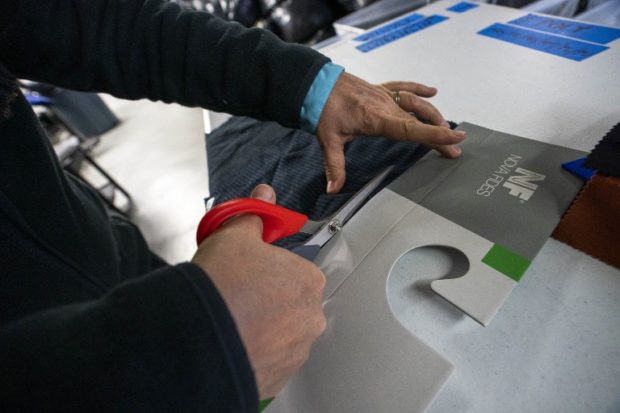In New York, one non-profit looks to combat textile waste

A Fabscrap volunteer removes labels and packaging from fabric on February 1, 2019 at the company’s warehouse in New York. AFP
NEW YORK, United States — The fashion industry generates tons of fabric waste each year, notably in New York — one of the world’s shopping capitals and host twice a year to runway shows, a major contributor to the wider problem.
Enter Fabscrap, a non-profit organization dedicated to recycling and reusing textiles that are unsuitable for donation.
Every day, 3,000 pounds (some 1,350 kilos) of scraps arrive at the group’s massive warehouse in Brooklyn — part of a huge complex that used to belong to the US Army, according to Fabscrap founder Jessica Schreiber.
The organization has established partnerships with about 250 ready-to-wear labels and several haute couture houses — and the waste they collect is representative of that variety.
You see everything in the warehouse piles: from luxury pieces by the likes of Oscar de la Renta or Marc Jacobs, to mainstream retail labels like J.Crew, to scraps from the workshops of up-and-coming designers.
Article continues after this advertisementLast year, Fabscrap picked up a total of 150,000 pounds of fabric.
Article continues after this advertisementBut Schreiber says there is a wide potential to do more, as that number only accounts for a third of the textile waste generated by the fashion industry in the Big Apple.
“After fashion week, we get really busy,” the 30-year-old Schreiber told AFP — that date has arrived, as Wednesday was the last day of shows.
“The brands will do a big clean out after a season,” added Schreiber, who was surrounded by huge black garbage bags filled with scraps that need to be sorted.
She says the fashion world is under “growing pressure” to do more to protect the environment.
Fabscrap offers its clients annual data about how much of their fabric waste is actually recycled or reused, and calculates their carbon footprint savings.
Volunteers do most of the fabric sorting — for every three hours of work, they can take home five pounds of scraps and buy more at a lower rate than is offered to fashion students, artists and do-it-yourself seamstresses.
Tiny scraps are sent to a shredder for later reuse in home insulation materials, as filling for pillows, or in blankets used by moving companies.
Bits of Lycra or Spandex, which cannot be shredded, are used to fill punching bags for boxing gyms.
In all, 54 percent of the fabric collected is recycled, another 41 percent is resold and five percent ends up in the landfill — the worst option, for the self-proclaimed “trash nerds” at Fabscrap.
‘A whole mountain!’
Fabscrap was born out of Schreiber’s inability to effect as much change as she would have liked in her post at the New York City Department of Sanitation, working on recycling and sustainability.
She was in charge of recycling the whopping 200,000 tons of clothes, shoes and household linens thrown out by New Yorkers each year.
Fashion companies were calling her to ask what to do with their scraps, but city hall didn’t have time to handle their requests.
Schreiber, who earned a Master’s degree in climate and society at Columbia University in the city, decided to launch an association to respond to their unfulfilled needs.
For a year and a half, she personally collected textile waste, bringing them back to her small apartment in taxis or rental trucks. She then sorted the scraps, and either resold them or took them to a shredder.
Today, Schreiber employs three young women, and is working with such larger amounts of fabric waste that she needed warehouse space.
“If we didn’t exist, a lot of this would be landfill,” and only a small fraction would be reused, she says.
While other recycling and reuse initiatives exist in the United States and Europe, Fabscrap is one of the rare groups to accept any and all fabrics, and one of the few to work with so many different types of companies.
Molly Boord, a 23-year-old volunteer, is a student at Columbia who recently took up sewing as a hobby.
“I knew the fashion industry had a lot of waste but I didn’t know it was a whole mountain!” Boord told AFP as she worked.
Another volunteer, 26-year-old Beck Dillenberger — a student at the prestigious Fashion Institute of Technology — meticulously sorts fabrics into piles: cotton, wool, blended material, Lycra.
“There needs to be sustainability” in the textile industry, said Dillenberger, who explained she collects fabrics and sometimes reuses the linen threads for embroidery.
“I feel good to contribute — everyone can do their part.” /ee